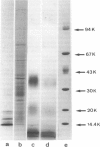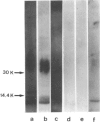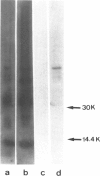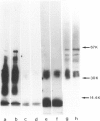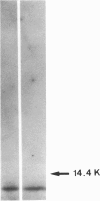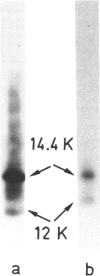Abstract
Studies have been conducted to characterize M. leprae bacilli derived from infected armadillos. First, the proteins of the mycobacterial extracts were fractionated by SDS-PAGE. Subsequently, the proteins in the gel were electrophoretically transferred on a strip of nitrocellulose paper by the technique of 'electrophoretic blotting'. The separated bacterial protein bands, thus immobilized on the nitrocellulose paper were made to react immunologically with sera from the lepromatous patients, infected armadillo sera and other experimental mycobacterial antisera. It was observed that a majority of M. leprae proteins contained antigenic determinants also present on proteins of BCG. In addition, only two specific antigen bands of 33KD and 12KD were conspicuously detected by the patients' sera and the infected armadillo sera. These substances were further identified as polysaccharides or glycoproteins since they could only be stained by Schiff's reagent or alcian blue. Only 12KD glycoprotein band reacted with concanavalin A, whereas wheat germ agglutinin (WGA) did not show any reaction with them. These 33KD and 12KD glycoprotein antigens were found to lose their antigenicity after pepsin treatment and can be considered as glycoproteins. Further, radiolabelling experiments showed that 12KD antigen underwent radioiodination under usual conditions, but 33KD glycoprotein failed to be similarly radiolabelled. It is suggested that these protein antigens have M. leprae specific determinants on a cross-reacting component.
Full text
PDF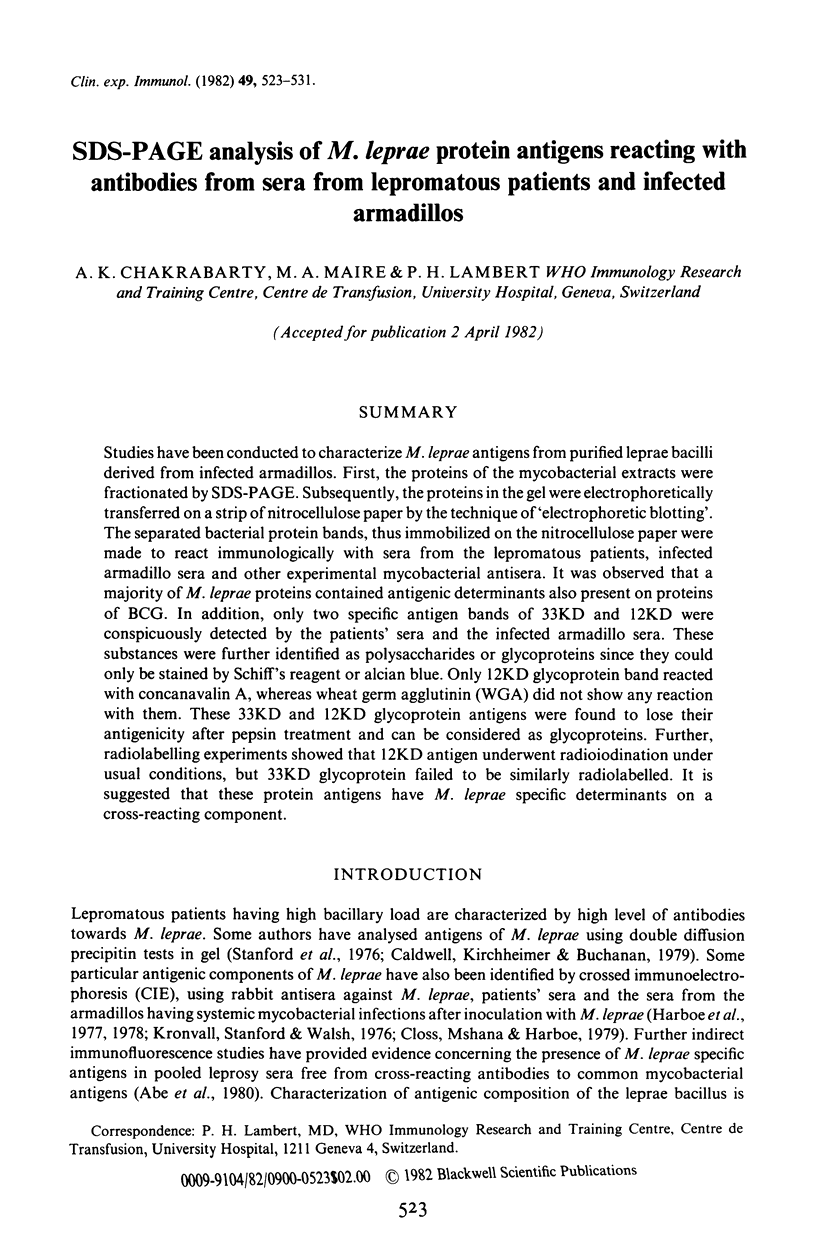
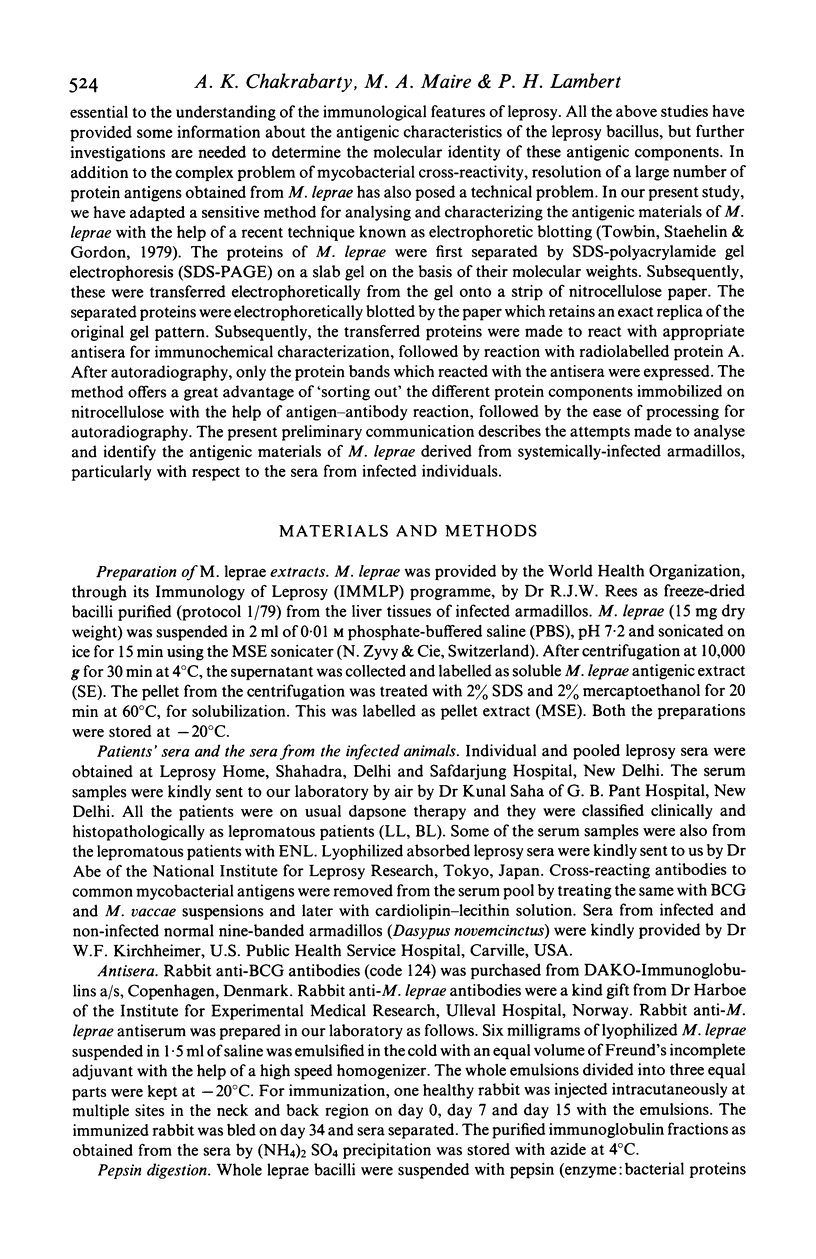

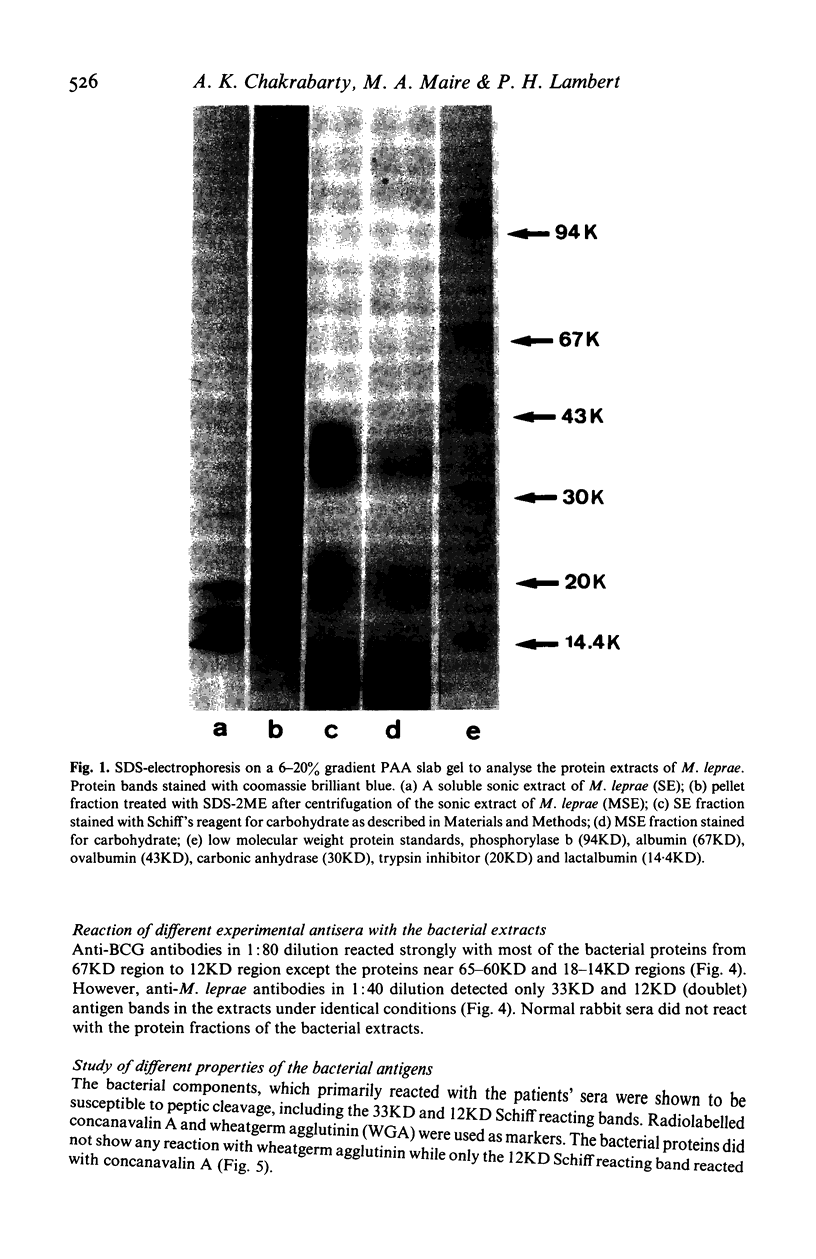
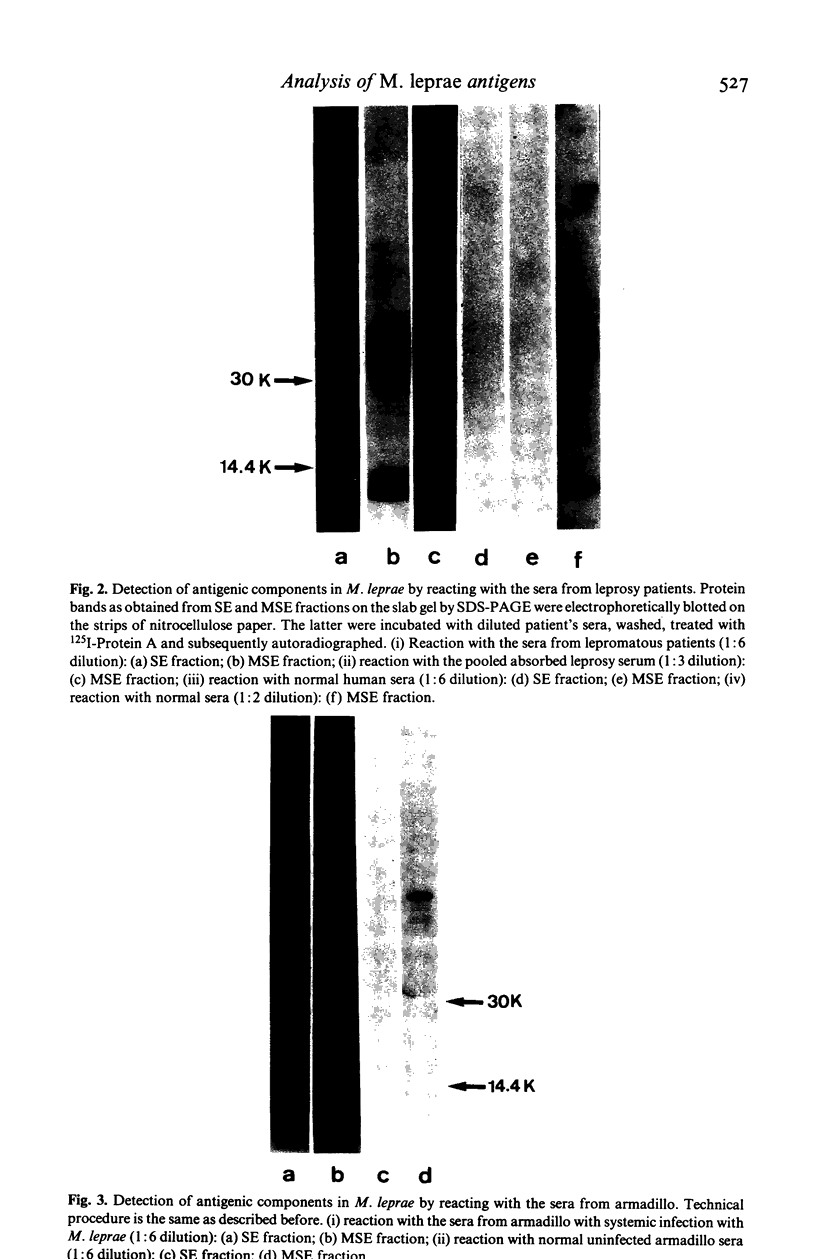
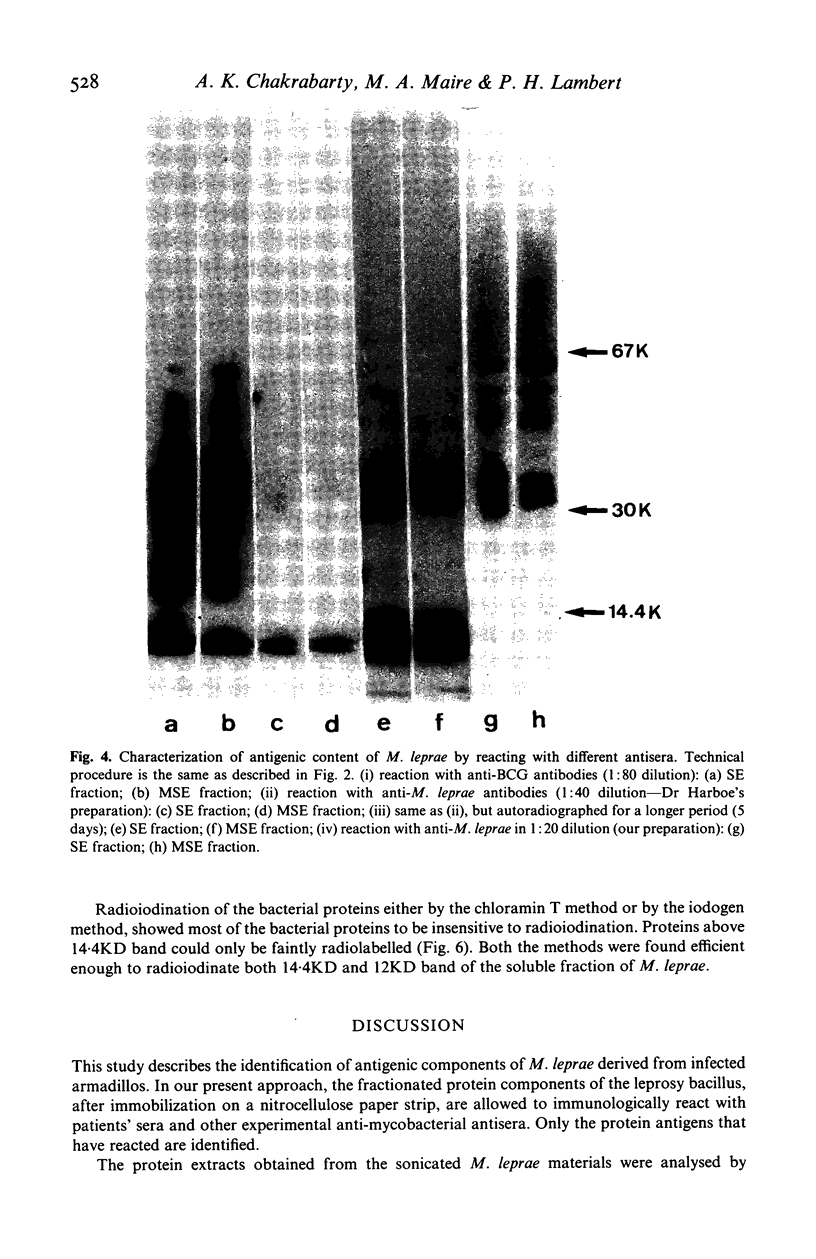
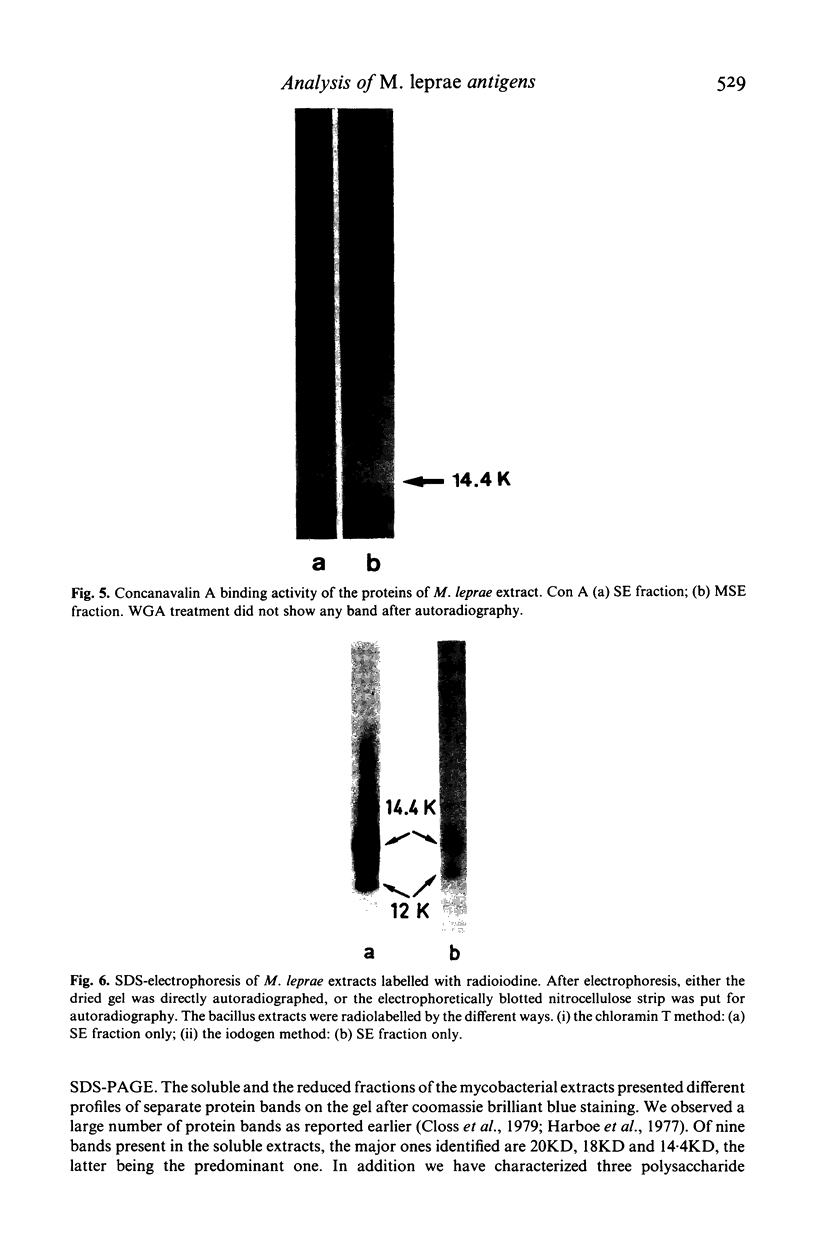

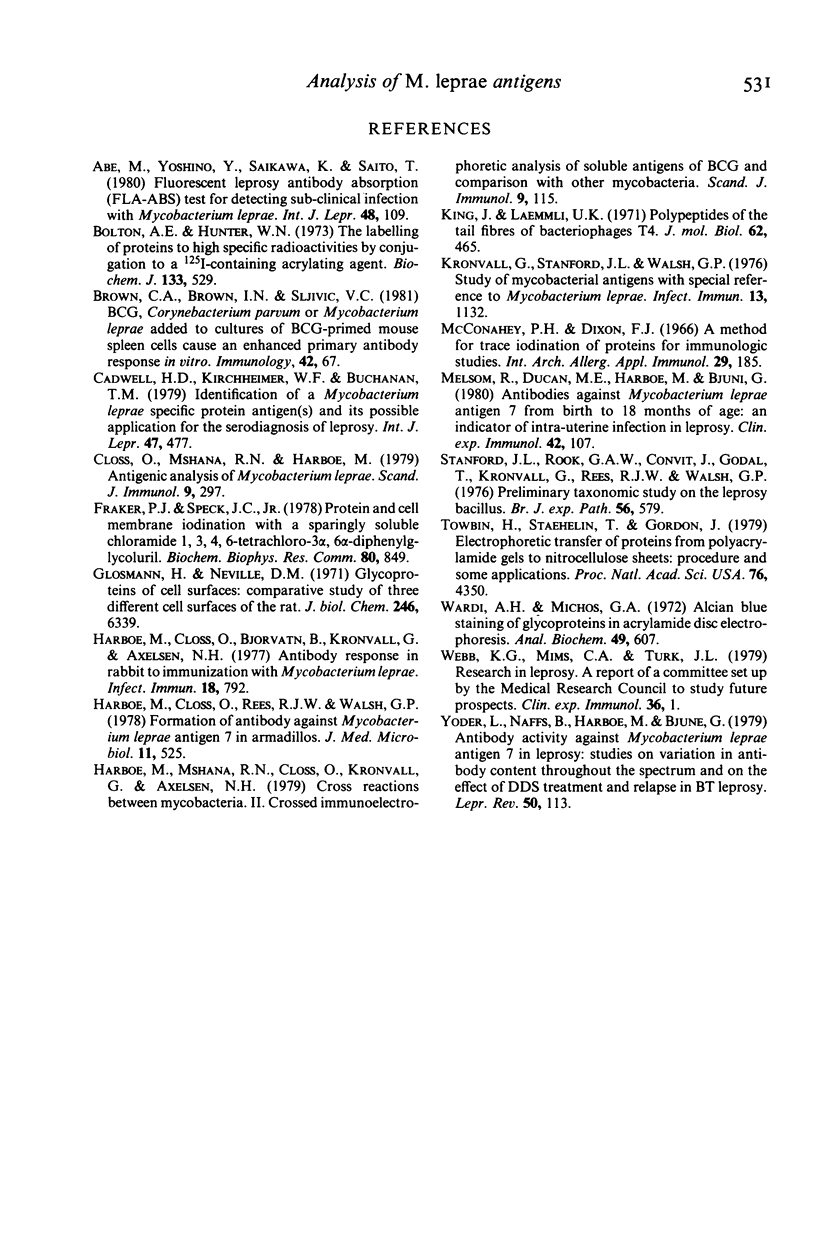
Images in this article
Selected References
These references are in PubMed. This may not be the complete list of references from this article.
- Abe M., Minagawa F., Yoshino Y., Ozawa T., Saikawa K., Saito T. Fluorescent leprosy antibody absorption (FLA-ABS) test for detecting subclinical infection with Mycobacterium leprae. Int J Lepr Other Mycobact Dis. 1980 Jun;48(2):109–119. [PubMed] [Google Scholar]
- Bolton A. E., Hunter W. M. The labelling of proteins to high specific radioactivities by conjugation to a 125I-containing acylating agent. Biochem J. 1973 Jul;133(3):529–539. doi: 10.1042/bj1330529. [DOI] [PMC free article] [PubMed] [Google Scholar]
- Brown C. A., Brown I. N., Sljivić V. S. BCG, Corynebacterium parvum or Mycobacterium leprae added to cultures of BCG-primed mouse spleen cells cause an enhanced primary antibody response in vitro. Immunology. 1981 Jan;42(1):67–73. [PMC free article] [PubMed] [Google Scholar]
- Caldwell H. D., Kirchheimer W. F., Buchanan T. M. Identification of a Mycobacterium leprae specific protein antigen(s) and its possible application for the serodiagnosis of leprosy. Int J Lepr Other Mycobact Dis. 1979 Sep;47(3):477–483. [PubMed] [Google Scholar]
- Closs O., Mshana R. N., Harboe M. Antigenic analysis of Mycobacterium leprae. Scand J Immunol. 1979 Mar;9(3):297–302. doi: 10.1111/j.1365-3083.1979.tb02735.x. [DOI] [PubMed] [Google Scholar]
- Fraker P. J., Speck J. C., Jr Protein and cell membrane iodinations with a sparingly soluble chloroamide, 1,3,4,6-tetrachloro-3a,6a-diphrenylglycoluril. Biochem Biophys Res Commun. 1978 Feb 28;80(4):849–857. doi: 10.1016/0006-291x(78)91322-0. [DOI] [PubMed] [Google Scholar]
- Glossmann H., Neville D. M., Jr Glycoproteins of cell surfaces. A comparative study of three different cell surfaces of the rat. J Biol Chem. 1971 Oct 25;246(20):6339–6346. [PubMed] [Google Scholar]
- Harboe M., Closs O., Bjorvatn B., Kronvall G., Axelsen N. H. Antibody response in rabbits to immunization with Mycobacterium leprae. Infect Immun. 1977 Dec;18(3):792–805. doi: 10.1128/iai.18.3.792-805.1977. [DOI] [PMC free article] [PubMed] [Google Scholar]
- Harboe M., Closs O., Rees R. J., Walsh G. P. Formation of antibody against Mycobacterium leprae antigen 7 in armadillos. J Med Microbiol. 1978 Nov;11(4):525–535. doi: 10.1099/00222615-11-4-525. [DOI] [PubMed] [Google Scholar]
- Harboe M., Mshana R. N., Closs O., Kronvall G., Axelsen N. H. Cross-reactions between mycobacteria. II. Crossed immunoelectrophoretic analysis of soluble antigens of BCG and comparison with other mycobacteria. Scand J Immunol. 1979;9(2):115–124. doi: 10.1111/j.1365-3083.1979.tb02713.x. [DOI] [PubMed] [Google Scholar]
- King J., Laemmli U. K. Polypeptides of the tail fibres of bacteriophage T4. J Mol Biol. 1971 Dec 28;62(3):465–477. doi: 10.1016/0022-2836(71)90148-3. [DOI] [PubMed] [Google Scholar]
- Kronvall G., Stanford J. L., Walsh G. P. Studies of mycobacterial antigens, with special reference to Mycobacterium leprae. Infect Immun. 1976 Apr;13(4):1132–1138. doi: 10.1128/iai.13.4.1132-1138.1976. [DOI] [PMC free article] [PubMed] [Google Scholar]
- McConahey P. J., Dixon F. J. A method of trace iodination of proteins for immunologic studies. Int Arch Allergy Appl Immunol. 1966;29(2):185–189. doi: 10.1159/000229699. [DOI] [PubMed] [Google Scholar]
- Melsom R., Duncan M. E., Harboe M., Bjune G. Antibodies against Mycobacterium leprae antigen 7 from birth to 18 months of age: an indicator of intra-uterine infection in leprosy. Clin Exp Immunol. 1980 Oct;42(1):107–113. [PMC free article] [PubMed] [Google Scholar]
- Research in leprosy. A report of a committee set up by the medical research council to study future prospects. Clin Exp Immunol. 1979 Apr;36(1):1–7. [PMC free article] [PubMed] [Google Scholar]
- Stanford J. L., Rook G. A., Convit J., Godal T., Kronvall G., Rees R. J., Walsh G. P. Preliminary taxonomic studies on the leprosy bacillus. Br J Exp Pathol. 1975 Dec;56(6):579–585. [PMC free article] [PubMed] [Google Scholar]
- Towbin H., Staehelin T., Gordon J. Electrophoretic transfer of proteins from polyacrylamide gels to nitrocellulose sheets: procedure and some applications. Proc Natl Acad Sci U S A. 1979 Sep;76(9):4350–4354. doi: 10.1073/pnas.76.9.4350. [DOI] [PMC free article] [PubMed] [Google Scholar]
- Wardi A. H., Michos G. A. Alcian blue staining of glycoproteins in acrylamide disc electrophoresis. Anal Biochem. 1972 Oct;49(2):607–609. doi: 10.1016/0003-2697(72)90472-1. [DOI] [PubMed] [Google Scholar]
- Yoder L., Naafs B., Harboe M., Bjune G. Antibody activity against Mycobacterium leprae antigen 7 in leprosy: studies on variation in antibody content throughout the spectrum and on the effect of DDS treatment and relapse in BT leprosy. Lepr Rev. 1979 Jun;50(2):113–121. doi: 10.5935/0305-7518.19790017. [DOI] [PubMed] [Google Scholar]



